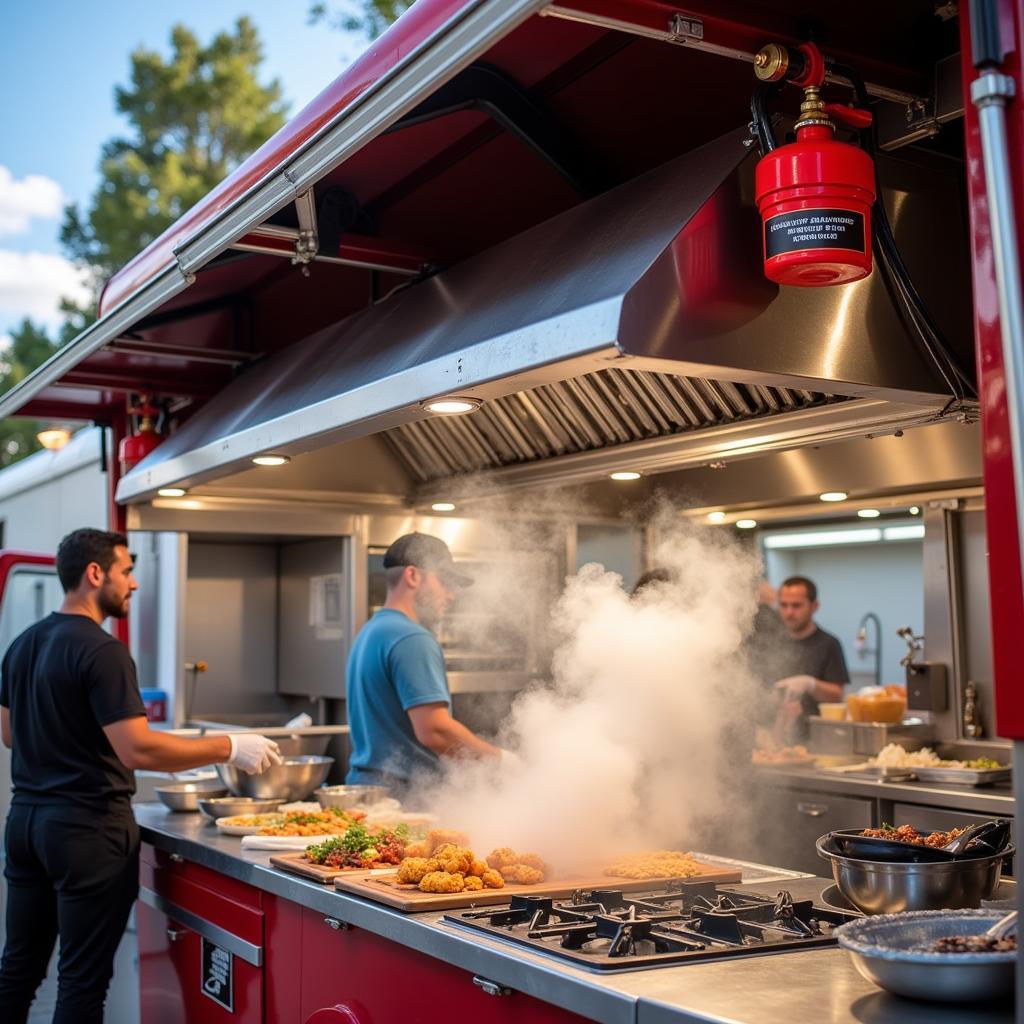A Food Truck Exhaust Hood With Fire Suppression is not just an accessory; it’s a critical safety feature and a legal requirement for most mobile food businesses. Choosing the right system will ensure the safety of your staff, protect your investment, and keep your delicious creations coming. Let’s delve into everything you need to know about these essential pieces of food truck equipment.
 Food Truck Exhaust Hood with Fire Suppression System in Action
Food Truck Exhaust Hood with Fire Suppression System in Action
Why is a Food Truck Exhaust Hood with Fire Suppression So Important?
Grease fires are a significant hazard in any kitchen, especially in the confined space of a food truck. A properly functioning exhaust hood removes grease-laden air, reducing the risk of fire. The integrated fire suppression system acts as your last line of defense, automatically extinguishing flames before they can spread. This not only protects your livelihood but also the lives of your staff and customers. Did you know that most municipalities require food trucks to have a certified fire suppression system installed as part of their licensing process? Investing in a quality system ensures you’re compliant and operating legally. Looking for the right hood system? Check out our comprehensive guide on hood system for food truck.
Understanding the Different Types of Fire Suppression Systems
There are two main types of fire suppression systems used in food trucks: wet chemical and dry chemical. Wet chemical systems are generally preferred for food truck applications due to their effectiveness in tackling grease fires and minimizing collateral damage. They use a potassium acetate-based agent that cools the fire and forms a soapy film, preventing re-ignition. Dry chemical systems, while effective, can leave a residue that can be difficult to clean. Choosing the right system for your specific needs is crucial, and consulting with a fire safety professional can help you make an informed decision.
How to Choose the Right Food Truck Exhaust Hood with Fire Suppression
Selecting the correct exhaust hood and fire suppression system for your food truck requires careful consideration of several factors. The size and layout of your kitchen, the type of cooking you do, and your budget all play a role. Need help understanding the requirements for your food truck? We’ve got you covered with our detailed guide on food truck hood requirements.
Key Considerations When Making Your Purchase
-
Hood Size and CFM: The cubic feet per minute (CFM) rating indicates the hood’s airflow capacity. A higher CFM is necessary for high-volume cooking.
-
Fire Suppression System Type: As discussed earlier, wet chemical systems are generally preferred for food trucks.
-
Installation and Maintenance: Choose a reputable installer and ensure regular maintenance to keep the system in optimal working order. You can find reliable options when searching for a hood for food truck.
-
Certification and Compliance: Ensure the system is certified by a recognized authority like UL or NFPA.
Maintaining Your Food Truck Exhaust Hood and Fire Suppression System
Regular maintenance is essential to ensure the longevity and effectiveness of your system. Inspections should be conducted at least every six months by a qualified technician. This includes checking the nozzles, piping, and the fire suppression agent levels. Cleaning the hood regularly will also help prevent grease buildup, reducing the fire risk. Thinking of starting your own food truck business? Check out our selection of sprinter van food truck for sale.
Ensuring Long-Term Performance and Safety
By investing in a high-quality food truck exhaust hood with fire suppression and adhering to a regular maintenance schedule, you’re ensuring the safety of your staff, protecting your investment, and setting your business up for success. A properly functioning system offers peace of mind, allowing you to focus on what you do best: creating delicious food.
Conclusion
A food truck exhaust hood with fire suppression is a vital investment for any mobile food business. It not only safeguards your business but also ensures the safety of your team and customers. Choosing the right system and maintaining it properly will contribute significantly to the long-term success of your food truck. Explore our range of food truck hood system options to find the perfect fit for your needs.
FAQ
- How often should I have my fire suppression system inspected? (Every six months)
- What is the difference between a wet chemical and dry chemical system? (Wet chemical systems use a potassium acetate-based agent, while dry chemical systems use a powder-based agent.)
- What is CFM and why is it important? (CFM stands for cubic feet per minute and measures the airflow capacity of the hood.)
- Do I need a professional to install my exhaust hood system? (Yes, professional installation is highly recommended.)
- Where can I find certified fire suppression systems? (Consult with a reputable fire safety equipment supplier.)
- What are the typical food truck hood requirements? (Requirements vary by location; check with your local authority.)
- How do I clean my food truck exhaust hood? (Regular cleaning with degreasing agents is essential.)
Common Scenarios and Questions
- Scenario: Your fire suppression system accidentally discharges. What should you do? Answer: Evacuate the truck immediately and contact a qualified technician to inspect and recharge the system.
- Question: Can I install a used exhaust hood system in my food truck? Answer: While it may seem cost-effective, using a used system can be risky. It’s always best to invest in a new, certified system for optimal safety and performance.
Further Reading and Resources
Check out our other articles on food truck equipment and safety regulations for more valuable information. We also recommend exploring resources from the National Fire Protection Association (NFPA) for comprehensive guidelines on fire safety.
Contact Us
For assistance with food truck exhaust hoods and fire suppression systems, contact us at: Phone: 02437655121, Email: minacones@gmail.com or visit us at: 3PGH+8R9, ĐT70A, thôn Trung, Bắc Từ Liêm, Hà Nội, Việt Nam. Our customer service team is available 24/7.